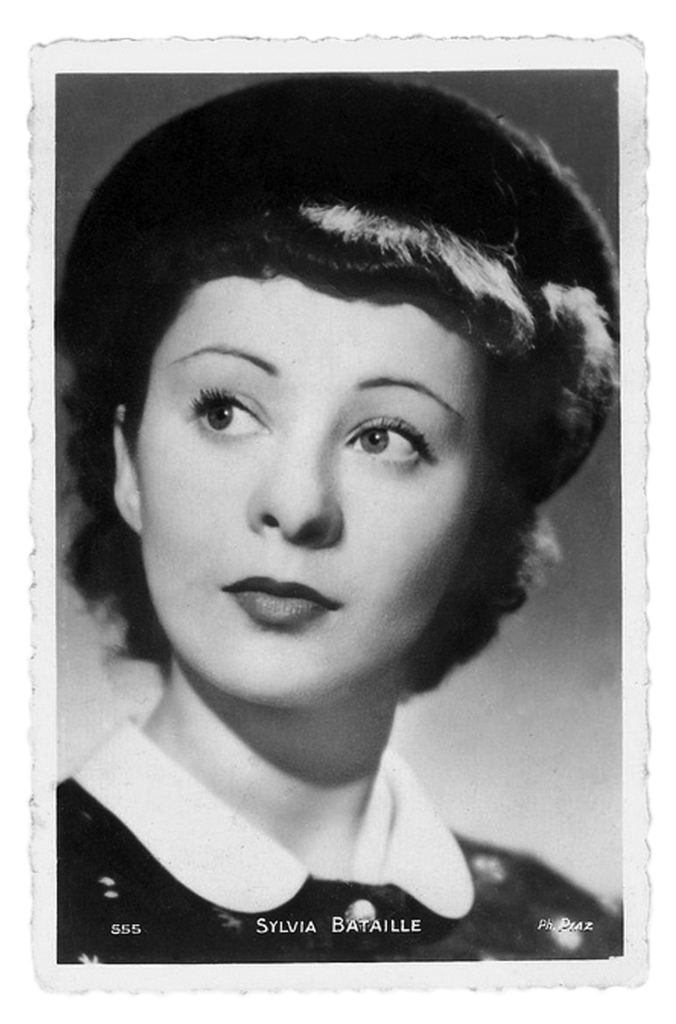Sylvia Bataille

SYLVIA BATAILLE
Organized by Adam Marnie and Rebecca Matalon
Opening reception, Friday, October 23, 7-9pm
October 23-December 20, 2015
Michel Auder | John Boskovich | Harry Dodge | Albert Herter | Christopher K. Ho, John Magee, Cynthia Talmadge, and Kevin Zucker | Jackie T. Kennedy and Sean Kennedy | Justin Lieberman, Mariah Robertson, and Stephanie Weber | John Miller and Aura Rosenberg | NOWORK | Eileen Quinlan and Cheyney Thompson | Roni Shneior and Barak Zemer | Matt Wycoff
SCREENING SERIES
Thursday, November 19, 7:30pm: Kathy Acker and Alan Sondheim, Blue Tape (1974), 55 minutes.
Friday, December 11, 7:30pm: Peggy Ahwesh and Keith Sanborn, The Deadman (1989), 35:56 minutes. This program will be introduced by poet, art critic, and author Maggie Nelson.
Sylvia Bataille (nee Maklès, 1908–1993) was a Romanian-Jewish French film actor married to philosopher Georges Bataille and, later and until his death, psychoanalyst Jacques Lacan. Despite being married to two of the most radical intellectuals of the 20th century, and both men prolific writers, Sylvia Bataille remains largely unknown. Sylvia Bataille’s biography takes shape through a small number of articles, interviews, and obituaries, her story told in a few short pages within her husbands’ lengthy biographies. The facts are so few that any telling of it necessitates construction into what quickly becomes an embellished fiction. Georges Bataille never wrote a word about Sylvia Bataille, save perhaps that in his novel Blue of Noon (1957), the character of Edith is allegedly modeled after her. Once, in 1955, Lacan dedicated a lecture to Sylvia Bataille.
In 1928 and at the age of nineteen Sylvia Maklès wed a thirty-year-old Georges Bataille. Her three sisters also married into the center of this French intellectual and artistic circle—Bianca Maklès to Théodore Fraenkel, Simone Maklès to Jean Piel, and Rose Maklès to André Masson. It was during her marriage to Georges Bataille that Sylvia Bataille first appeared in film as the voice of a rabbit in the animated feature Le Roman de Renard (The Tale of the Fox). Sylvia and Georges Bataille separated in 1934, six years after marrying and four years after the birth of their only child, Laurence Bataille. They remained legally wed until 1946. Over a brief but concentrated period between 1930 and the onset of World War II, Sylvia Bataille appeared in more than twenty films. She was awarded the Prix Suzanne Bianchetti in 1939, an annual award given to the most promising young French actress. Her first big leading role came in 1936 as the female protagonist in Jean Renoir’s acclaimed Une Partie de Campagne (A Day in the Country). It would be ten years until the film was released. In 1938 Sylvia Bataille began a relationship with a married Jacques Lacan. Two years later and shortly after the German army invaded Paris, a pregnant Sylvia Bataille fled the city for the south of France. In the summer of 1941 she gave birth to a daughter by Lacan, Judith. Lacan and his first wife Marie-Louise Blondin would divorce by the end of the year. Sylvia Bataille acted in only a handful of films after the war, making her final appearance on screen in 1950. On July 17, 1953, Jacques Lacan and Sylvia Bataille married.
Besides an eponymous 2013 French biography described by its publisher as a roman biographique, the most substantial account of Sylvia Bataille is a doctoral thesis by Jamer Hunt, submitted to the Department of Philosophy at Rice University in 1995. Piecing together the minimal biographical information on Sylvia Bataille, Hunt builds a narrative that verges on creative non-fiction. The bulk of his paper is a personal and obsessive search for Sylvia Bataille taking the form of journal entries that chronicle attempts to gain access to her. Hunt’s dissertation culminates with their sole interview, conducted in her Paris apartment in 1993. “I don’t have much to tell. I feel very bad for you,” Sylvia Bataille self-effacingly and acerbically tells her interviewer. The least specious sections of the text are those in which Hunt weaves in documents such as film reviews of Une Partie de Campagne and a selection of obituaries from French newspapers. The cited film reviews, nearly all authored by men, conflate Sylvia Bataille and the character she plays—the critics’ apparent fetishization of her image mirroring Hunt’s own. What appears throughout these fragments is a perpetual reference to and reduction of Sylvia Bataille to her face or eyes. Projecting sensuality, desire, and eroticism onto her face, they cut her up (admittedly, taking cue from Renoir’s cinematography and frequent use of the close-up). Crucially, it is Sylvia Bataille’s face that is excised and not that of her character Henriette Dufor. What we are dealing with here, what Hunt encourages we take as historical record, is only ever fantasy.
Sylvia Bataille haunts. True to form, in her ghost-like haunting she is a blur. Just when she appears most clearly, when the edges of her life come into view, her figure falls away. In this respect, historical research carried out in her name can do little more than add to the fantasy of Sylvia Bataille. This exhibition is bound by the same constraints. But as a conscious effort to add to this fantasy it is also a stopgap—an attempt to let the blur of Sylvia Bataille spread out and swell without getting more diffuse.
Thanks to: China Art Objects, Los Angeles; EAI (Electronic Arts Intermix, New York); Light Industry, New York; Martos Gallery, New York and Los Angeles; Melikseitan|Briggs, Los Angeles; Krista Montagna; Jin Son; Alan Sondheim; and Barak Zemer.
All images, installation views of SYLVIA BATAILLE, JOAN, Los Angeles.
Click here for Exhibition checklist PDF
[rev_slider sylvia_bataille]

0